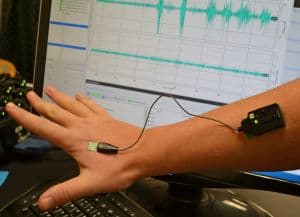
How knee replacements affect golf swing is one of several studies at the Human Motion Laboratory, fully-equipped, human motion biomechanics laboratory
Orthopaedic Research Laboratories
A coordinated group of laboratories and research space, known collectively as the Orthopaedic Research Laboratory, occupies almost 4500 square feet and is located on the UAMS main campus in the Winthrop P. Rockefeller Cancer Institute building, one level below the department’s administrative offices. The modern day lab is used by orthopaedic researchers, physicians, fellows, graduate students, medical students and others performing musculoskeletal research.
The UAMS Cadaveric Biomechanics Laboratory houses the MTS Bionix Spine Kinematics System, a custom 6 degree-of-freedom spine biomechanics stimulator that is designed specifically for evaluating the behavior of spine specimens. The lab also contains Optotrak Certus®, a research-grade motion tracking system that features exceptional spatial and temporal accuracy, as well as a novel pressure sensing system for joint loading.
The UAMS Biomechanics, Histology, and Imaging Core Laboratory provides bone histology services for multiple clinical and basic science departments at UAMS. It also houses EOS®, a state-of-the-art low dose, biplanar X-ray imaging system, currently being utilized in whole body alignment studies.
The UAMS Micro CT Core Laboratory contains the Bruker microCT, a system that uses high resolution x-ray imaging to construct a detailed three-dimensional visualization of an object, enabling the internal structure of an object to be determined non-destructively.

Electromyogram testing – to detect muscle activity – is one of several technologies in use at the Human Motion laboratory that allows researchers insight into human movement.
The department also utilizes a fully-equipped, human motion biomechanics laboratory located off campus known as the
UAMS Motion Analysis Laboratory, that can perform stride analysis, force plate measurement, balance assessments, EMG testing, and other biomechanical studies of the spine, bone and joints. This high tech lab houses a 10-camera Vicon motion capture system, 16-channel Delsys EMG system, 4 AMTI force plates, a novel pressure sensing system including insoles and pads, 9 XSENS IMUs, and a Trackman golf radar system. Human beings are continuously subjected to the universal force of gravitation, and thus to forces from within and surrounding the body. The goal of our biomechanics research is provide clinicians and scientists an opportunity to examine and quantify the interaction of these forces and their effects on the form, function, and motion of humans and apply the resulting knowledge in order to restore movement and promote quality of life.
The research endeavors conducted within our facilities are supported by highly skilled research faculty and state-of-the-art equipment.